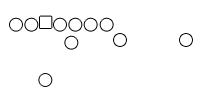Single-wing football offense
a.k.a. single wing

The single-wing football offense is an 11-man offense, as opposed to the usual 10-man offense where the quarterback goes off duty after giving the ball to someone else. The most current and famous version of it is the "Wildcat" formation, as made famous in 2008 by the Miami Dolphins.
Once the dominant offense in football
The single-wing offense, although currently out of fashion with high school and higher level coaches is one of the soundest, most proven offense in football. It was invented by Pop Warner, who was the winningest college coach of all time until just recently. Almost all college national championships and NFL championships from 1912-1940 were won by single-wing teams.
"What would happen if someone came out with a single-wing offense? It would embarrass the hell out of us." -Vince Lombardi


The T-formation worked well back then mainly because the defenses were all geared up to stop the single wing. Now, the exact opposite is true. The defenses are geared up to stop the T-formation. Today, the typical offense at the youth and high school levels is a pro set I (tight end and flanker on one side; split end on the other; fullback and tailback in the backfield). In response, the typical defense is a 5-3. That is a very poor defense for stopping the single wing, which is why most of my readers have been kicking butt with the single wing around the U.S. and Canada. See the reader comments for my book Single-Wing Offense for Youth Football.
Single-wing coaches association
Having trouble selling the single-wing? Use these success stories.
Single-wing coach directory
“It was difficult to get teams to schedule you when you’re the only one they’ll face playing the single wing.” Terry Baker, 1962 Heisman Trophy winner at Oregon State.
Howard Cosell writes in What's Wrong With Sports, 1991, "One thing I have found very interesting in my conversation with (Bill) Walsh is that he regretted he never tried the single-wing formation with the 49ers. He felt that Steve Young could have run the formation to perfection, and that the league's defenses would have had a difficult time stopping the old formation." p.318